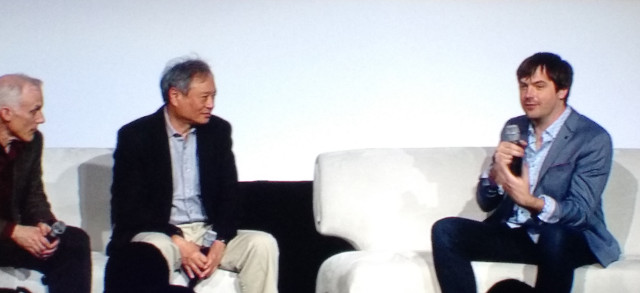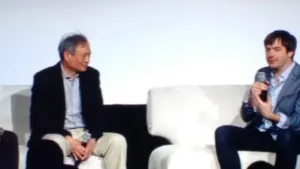Ang Lee looks to be the first major director to get the green light for a Hollywood production using 120Hz frame rates. However, major questions remain about exhibitor’s ability to actually screen the movie at 120 fps and in 3D. Only Trumbull’s Magi technology is capable of showing films at more than 60 fps and there is no installed base of projectors. The movie is set to release in the fall.
So far, only Peter Jackson’s The Hobbit: An Unexpected Journey has been screened widely in a higher frame rate – 48 fps in this case – to a wide range of review opinions. James Cameron has said he will shoot and release future Avatar films in a higher frame that most believe will be 60 fps.
At NAB, Lee showed a screening from ‘Billy Lynn’s Long Halftime Walk’ and was composed of an 11-minute clip from the upcoming film. Lee introduced the screening and noted that there were some issues with the content they were aware of and fixing. The movie is still in post production so he asked for understanding for the not-quite-perfect screening.
He asked that no details of the movie plot be revealed, but I think it is fair to say it is based on the experience of a young soldier in combat in Iraq and his subsequent hero’s welcome during a SuperBowl halftime show. The content is riveting. The first thing you notice is how sharp, clear and realistic the 4K, 3D, 120 fps images are. They do not have the typical cinematic look – that is for sure, but it is not something that anyone has really experienced before. One sequence is a battle scene that feels so real that it is a nerve racking experience. The image quality makes you feel as if you are almost there so you connect very emotionally with the content.
We also had a chance to talk to Larry Paul, whose Christie projectors enabled the screening and Florian Maier from Stereotec, whose 3D rig was used to capture the content.
Paul said that the screening was enabled by two Mirage 4K LH projectors. These unit are designed for the Vis/Sim and rental and staging market and are the only projectors capable of showing 4K content at 60 fps using a 1.2 Gbps pipeline. For the screening, only the projector heads from the Mirage units were used and each was fed by four RGB laser modules – the same modules used in RGB cinema projectors. We asked if this was the first time RGB laser had been fed to the Mirage projectors and Paul said this was the first public showing. In fact, the configuration has been done before but all in NDA installations. We suggested that customers in automobile simulation and theme parks were likely candidates and he nodded.
Powering the screening were two 7th Sense servers – each running one “eye” of content in synchronization. Signals are delivered from each server over a quad Displayport connection. It is a 6p 3D solution so spectral glasses from the cinema were used by the audience. Laser light is delivered by fiber to the projector heads and Paul said that luminance to the eye was a corrected 28 fL or about 100 nits. The high brightness, low crosstalk and well executed stereoscopic capture and processing made the 3D feel very natural. I only saw two minor issues.
It should be noted that this is not an HDR projection solution as the Mirage heads do not support very high contrast. But the content can be screened in any color gamut up to and including 2020. There were some scenes with red, white and blue flag colors that looked very saturated and could indeed have been outside of the DCI-P3 color gamut.
Maier told us that the film was captured with Sony F65 cameras and that Lee did a shoot out with three 3D rig providers (StereoTec, Pace and 3ality) before choosing Stereotec. They had to modify their rigs a little to accommodate the large-sized F65 cameras in a beam splitter configuration. They also did some updates to allow remote control of the rig, per Lee’s request. The F65 captured the images in 3D, 4K 120 fps and were stored in a RAW format. That’s a lot of data! The movie was shot in Atlanta and Morocco.

After the screening, Ang Lee and his top creative staff participated in a panel discussion at the Future of Cinema conference. Lee confesses he is not a technology guy and you can tell he loves to connect deeply and emotionally with the films he makes. And he prays a lot to the movie gods.
One of the key benefits that he and his technical team emphasized was the flexibility of the capture format they choose. Lee noted that there used to be three distinct phases of movie production once the script was done and the project went ahead: pre-production, production and post-production. Now, these are all merging together said Lee. He essentially called the production phase “data capture” as so much can be done with this later. He is also very humble saying that they don’t know what there are doing half the time.
Post production is taking place in a studio in New York where colorists, editors, VFX experts and others all reside. This has been a big benefit for the team as they can review and solve problems and manage data locally – not globally. A dual-projector set up is used on-site for editing and review.
Like the move from SD to HD and to 4K, each jump reveals new issues with the production process. For this movie, make up on the actors is now visible, so it is not allowed. Lee says it also provides a new window into the actor’s heart and soul that was not possible before.
He cited one example where he looked at a daily in 4K 60 fps and thought the acting was bad. Later, when he saw the same shot in 120 fps, he had a different, more positive reaction. His conclusion is that the format is doing some subtle and unknown things in the way people connect with the content, making it a very powerful tool*. The 4K/3D/120 fps image makes people more alert and emotionally engaged with the image, thinks Lee.
Most importantly, the high frame rate and 360-degree shutter angle capture allow for all kinds of flexibility in post production. For example, creation of screens that playback at 24, 30 or 60 fps are possible. This is not necessarily simple deletion of frames from the 120 master, but a complex averaging that can even take pieces from one set of frame to average along with different pieces from other frames.
In addition, there is the ability to change the shutter angle in any sequence to reduce any motion blur or add a strobing look. Creation of a typical cinematic look at 24 fps with equivalent motion bur is possible – along with everything in between. The team is even thought to be looking at variable frame rates.
Clearly, this movie will only have a few sites that are likely going to be able to screen the movie in its native 4K/3D/120 fps format. No plans for this were announced, but it would not be surprising if plans were already afoot.
About three quarters of the current digital cinema theaters worldwide have series 2 electronics. That means they will be capable of showing:
- 120 fps, 2K resolution, 2D or
- 60 fps, 2K resolution, 3D
Showing the film in 3D and 120 fps will be possible, but requires two projectors and can only reach 2K resolution.
To get to 4K/3D/120 fps will require the dual Mirage set up shown at the event. I for one, can’t wait to see if these theaters will become available so I can see the whole movie. -CC
* It seems to me that the 120Hz might allow the capture of ‘micro-expressions’, fleeting expressions that may be displayed inadvertently when people are under stress. I have read that an ability to capture these micro-expressions might some people be more empathetic than others. BR

